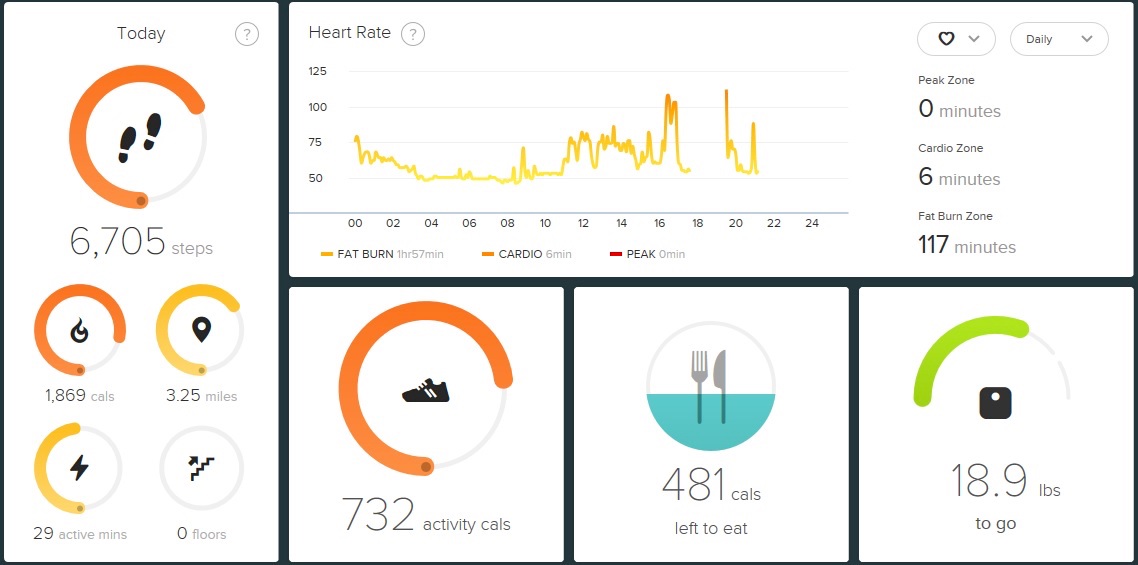As usual at this time of year, there are a couple of extra pounds going spare around the Cambridgeshire Walks' waistline. Often takes until April to get back to fighting weight. With the gift of a second hand Fitbit Charge HR, this year things have changed. Within two weeks all trim and tidy in spite of being surrounded by sweet stuff. Here's the low down on losing weight.
Cambridgeshire Walks is all about gentle exercise. None of your expensive gym contracts, gritted teeth press-ups or early morning jogging. Relaxed ambling through green countryside every time. But if you're keen to get trim, exercise is just one half of the equation.
Consider what you eat and drink. Take in the same number of calories as you burn in exercise and your weight will remain stable. More in and you put on weight. Less in and you lose weight. Count calories as well as measure exercise and you have a sure fire way of having a handle on how you're doing.
All sounds a bit tedious? Doesn't have to be. Just a simple investment of a few minutes each day. Best time is early evening, when chocolate treats and a glass of wine are calling you. Check your calorie input versus output for the day against your target. Then you'll know if you've got room for the treats. Don't give up the nice to have stuff. Just manage it better.
What's this 'target' thing? Recommended daily calorie intake is 2,500 for men, 2,000 for women. As a rough guide, reduce your intake by 500 calories and you'll lose one pound of weight per week. Extra exercise such as a long walk will help to lose weight more quickly. The NHS has set a 10,000 steps a day challenge, which equates to more than their recommended 150 minutes of exercise a week.

From using the latest technology to pen and paper, here are three suggestions to keep track.
1. Pen and paper
The basic method is to get a notebook and split each page into diet and exercise sections. You'll walk at least 3,000 steps a day just around the home and at work, so the steps column starts with that amount. For an example, click here. A pocket book giving guidance on calories costs under £5. The Collins Gem Calorie Counter is a good choice. If you're into notebooks, why not buy a good one and make it something of a pleasure. If you want premium, Moleskine notebooks are good. Or go for the ultimate at Bullet Journal, where you'll find loads of articles about how to record things with style as well as a mighty fine notebook.
2. A bit of technology
A basic pedometer to record daily steps can cost as little as £5. Free web based applications keep a record of steps and what you eat. The Fitbit web site is easy to use. As well as recording food, activities and weight, you get a great dashboard summary of how you're doing (see image above). If you have a smartphone, download the Fitbit app to keep track on the move. There are also apps to record steps, though they can drain your battery.
3. Using technology
The easiest option is to use a fitness tracker. It will record calories burned and heart rate as well as steps. Some do much more. Linked to an app on your smartphone, the tracker automatically uploads your daily progress and the app or website presents a summary against target. All you have to do is log what you eat and drink. If that sounds a bit tedious, it isn't. Generally your diet repeats the same foods, and most of the apps keep a record of your most often used foods. You'll pay from £50 upwards for a fitness tracker, a lot less if you buy used.
Cambridgeshire Walks is all about gentle exercise. None of your expensive gym contracts, gritted teeth press-ups or early morning jogging. Relaxed ambling through green countryside every time. But if you're keen to get trim, exercise is just one half of the equation.
Consider what you eat and drink. Take in the same number of calories as you burn in exercise and your weight will remain stable. More in and you put on weight. Less in and you lose weight. Count calories as well as measure exercise and you have a sure fire way of having a handle on how you're doing.
All sounds a bit tedious? Doesn't have to be. Just a simple investment of a few minutes each day. Best time is early evening, when chocolate treats and a glass of wine are calling you. Check your calorie input versus output for the day against your target. Then you'll know if you've got room for the treats. Don't give up the nice to have stuff. Just manage it better.
What's this 'target' thing? Recommended daily calorie intake is 2,500 for men, 2,000 for women. As a rough guide, reduce your intake by 500 calories and you'll lose one pound of weight per week. Extra exercise such as a long walk will help to lose weight more quickly. The NHS has set a 10,000 steps a day challenge, which equates to more than their recommended 150 minutes of exercise a week.

From using the latest technology to pen and paper, here are three suggestions to keep track.
1. Pen and paper
The basic method is to get a notebook and split each page into diet and exercise sections. You'll walk at least 3,000 steps a day just around the home and at work, so the steps column starts with that amount. For an example, click here. A pocket book giving guidance on calories costs under £5. The Collins Gem Calorie Counter is a good choice. If you're into notebooks, why not buy a good one and make it something of a pleasure. If you want premium, Moleskine notebooks are good. Or go for the ultimate at Bullet Journal, where you'll find loads of articles about how to record things with style as well as a mighty fine notebook.
2. A bit of technology
A basic pedometer to record daily steps can cost as little as £5. Free web based applications keep a record of steps and what you eat. The Fitbit web site is easy to use. As well as recording food, activities and weight, you get a great dashboard summary of how you're doing (see image above). If you have a smartphone, download the Fitbit app to keep track on the move. There are also apps to record steps, though they can drain your battery.
3. Using technology
The easiest option is to use a fitness tracker. It will record calories burned and heart rate as well as steps. Some do much more. Linked to an app on your smartphone, the tracker automatically uploads your daily progress and the app or website presents a summary against target. All you have to do is log what you eat and drink. If that sounds a bit tedious, it isn't. Generally your diet repeats the same foods, and most of the apps keep a record of your most often used foods. You'll pay from £50 upwards for a fitness tracker, a lot less if you buy used.


No comments:
Post a Comment